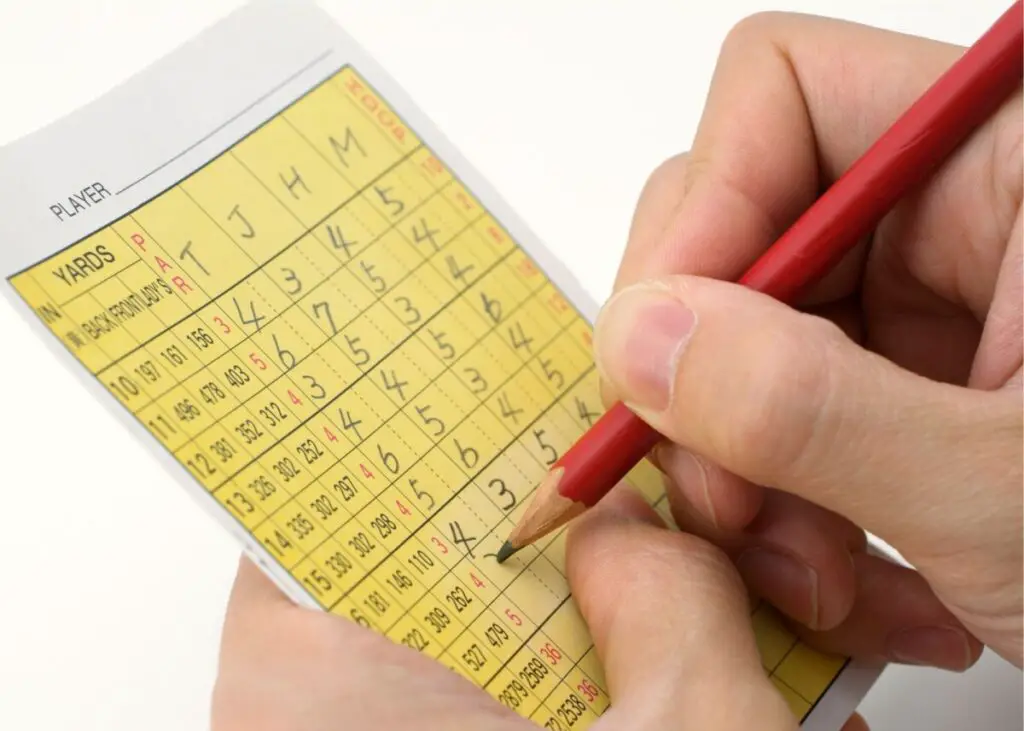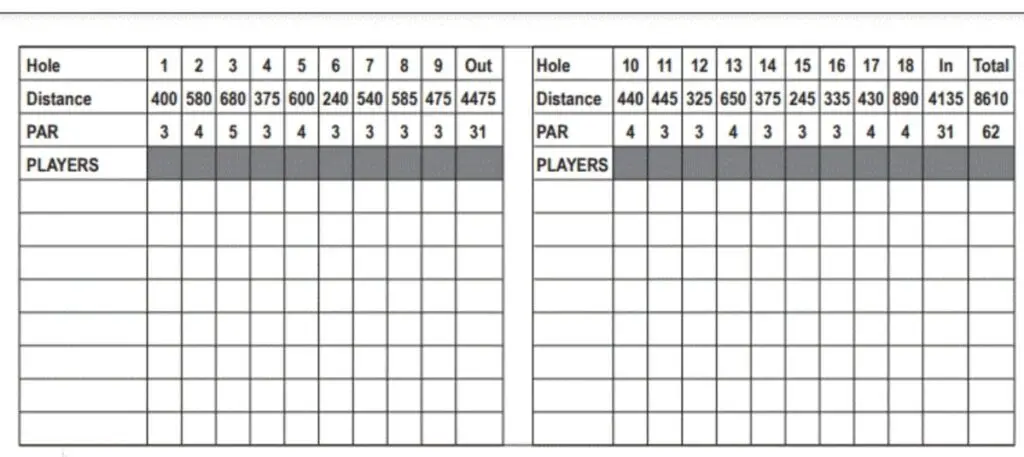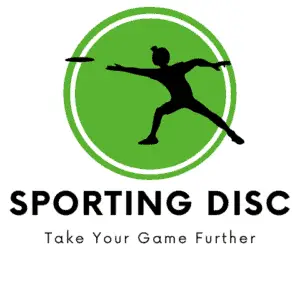Keeping score in disc golf is pretty easy if you understand the scoring method and basic terminology related to scoring a round of disc golf.
You don’t want to get caught not knowing how to properly keep score playing a round of disc golf with friends. In this post, you’ll learn everything you need to know to start keeping the score even as a beginner.
Table of Contents
Here’s How You Keep Score In Disc Golf
To keep score in disc golf, add up the strokes, or throws, to complete every hole on a course. At the conclusion of the round, each player totals their strokes. The player with the least amount of strokes wins. Throws are counted from the tee shot until the disc is thrown in the chains of the basket.
In this post, I’ll cover everything from scoring terminology, how to count penalties, and different methods to keep score.

Terms To Know For Keeping Score In Disc Golf
Disc golf is most similar to ball golf in the way that it is scored and the terminology used to keep score throughout the game.
Below are the common terms used in disc golf made about keeping score.
Ace
An ace in disc golf is the same thing as a hole-in-one in disc golf. In disc golf, we don’t refer to a hole-in-one because there is no hole to putt the ball into. Instead, it’s called an ace.
So, how do you score an ace? A player will get an ace when they only use one throw to get the disc from the tee to the chains in the basket. It’s not impossible to throw an ace either.
It’s much easier to score an ace in disc golf than it is in ball golf. When scoring an ace, you’ll only record one stroke on the scorecard.
Stroke
A throw is referred to as a stroke in disc golf. In ball golf, a stroke is referred to as a shot on the ball. It means essentially the same thing.
The number of strokes is what you’ll enter on your scorecard for each hole played.
Par
A par is one of the most basic scoring terms to understand. Par is the number of strokes designated to each hole to complete. A very long hole will have higher par than a shorter, easier hole.
You’ll often hear of a player throwing or shooting under par for their round.
Since each hole has a par, these are added up for a total number that is par for that particular course. If you finish a round under that number you’ve shot under par for the course.
For example, if you play a 9 hole course with a par of 60, and throw for a total score of 54, you’ve shot 6 strokes under par for the course.
Albatross
An albatross can only be scored when you complete a hole in three strokes under par. An albatross can also be called a double eagle.
The albatross is rare because it can only be scored on a hole that is a par 5. This means you’d have to hit the chains of the basket on your second throw from tee-off.
Eagle
An eagle is when a player completes a hole in two strokes less than par. For a par 5 hole, this would mean you’ve completed the hole in 3 strokes or three throws of the disc.
For a par 4 hole, an eagle would mean that you completed the hole in 2 strokes.
Birdie
A birdie is much more common in scoring. A player will throw a birdie when they complete a hole one stroke under par for that hole.
On a par 4 hole, a birdie would be 3 strokes from the tee to complete the hole.
Bogey
A bogey is less desirable. A bogey means that you’ve thrown one stroke over par for the hole. For every stroke over the bogey, you’ll keep adding to the original bogey, which I’ll explain.
Double Bogey
The double-bogey is now two strokes over par. It keeps going too. Three throws over par? You’ll have a triple bogey, and so on.
How Do You Know Who Wins in Disc Golf?
At the beginning of each hole on a disc golf course, there is a sign or marker that will let you know how many strokes it takes to score a par on that particular hole.
The goal in disc golf is to take the least amount of strokes to get the disc in the basket from the tee. The fewer throws the better.
After each hole, you’ll record the number of strokes for that hole and move to the next hole on the course.
After every hole is completed, tally up your strokes to get your score. You’ve won if you have the lowest score out of the group of players you’re competing against.
How Penalties Can Affect Your Score
Unfortunately, penalties are a part of the game too and they can negatively affect your score by adding additional strokes onto a hole.
Here are the most common penalties in disc golf.
Foot Fault
A foot fault is more complicated than you might think and will cost a penalty stroke.
A foot fault can occur for stepping out of the tee box area when throwing, or stepping too far forward on a fairway shot or putt.
As I alluded to, the foot fault rules can be a little confusing, and having a good handle on what a foot fault is (and isn’t) can keep you from losing strokes on the course.
Get a better understanding of foot faults by checking out this post here.
Out-of-Bounds Throw
Every hole on a disc golf course will have a designated area that is in-bounds, and another area that is designated as out-of-bounds.
Any disc that lands in an area that has been designated as out-of-bounds will be given a penalty stroke.
Mandatory (Mando)
Mandatory is shortened to Mando in disc golf. This means that certain obstacles like trees, utility poles, or any other object on the course can be marked as a mando.
Your disc has to travel past the correct side of the mando. If the disc doesn’t land on the right side of the mando, you’ll be assessed a penalty stroke on the hole.
Hazard
Hazards can come in many shapes and sizes depending on the course. Commonly a sand trap will be referred to as a hazard.
If your disc lands in a hazard there is a one-stroke penalty.
Two-Meter Rule
The two-meter is not always enforced at every course. What the two-meter rule means is that when a disc is stuck in an object two meters or more above the ground, you’ll have to take a one-throw penalty on the hole.
Courtesy Violation
Courtesy violations come into play mostly during a tournament. Disc golf, just like ball golf has a fair amount of etiquette that is expected when playing in competitive tournaments.
A courtesy violation will be given by another player or a tournament director. The first infraction will be a warning, but subsequent infractions will result in a one-stroke penalty.
Examples of a courtesy violation could be playing out of turn, distracting players during their shots, and other common courtesy violations.
What You Can Use To Keep Score
It’s best to use something to record your strokes for each hole on the course. If you’re playing to practice, you might only try to remember your strokes for each hole, but this can be unreliable.
Especially when playing with a group, the best way to keep score is to use a scorecard to manually keep score, or use a scoring app on your smartphone.
Hand-Written Scorecard
Sometimes each player will use their scorecard to keep their score, or one person will be designated to keep the score for each player in the group on the scorecard.
Here is what a sample disc golf scorecard looks like.

If you’re looking for a disc golf scorecard PDF to use, this one available from Innova can be downloaded and customized as needed.
Disc Golf Scoring App
Apps for a smartphone are quickly becoming the easiest, quickest, and most accurate way to keep score for each player.
There a several disc golf scoring apps to choose from. Of course, they don’t just keep score either. Most apps will keep track of a multitude of additional stats about your game so you can track your progress.
UDisc offers a great app for keeping scores during a round of disc golf.
Who Keeps the Score During a Disc Golf Round?
Anyone can keep the score during a round of disc golf. It’s best to designate one person to be in charge of keeping the score before starting the first hole.
If you’re following PDGA rules, this means the first person listed on the scorecard is the one that is tasked with keeping score for the ground during the round.
Your Score and Throwing Order
Your score can also determine the throwing order for each hole. Generally, the player with the lowest score for the previous hole will throw first to begin the next hole.
This means that the throwing order can change from hole to hole. So, keeping track of the score is important too for the next hole in case there is a dispute.
What is a Good Disc Golf Score?
A good score in disc golf can be relative to the person and their skill level.
A very experienced player might consider a good score to be very different from what a beginner considers a good score.
A good score can also be affected by the course itself. For example, the difficulty of each hole can mean what is a higher score compared to other courses is a good score at another course.
As a rule of thumb though, you can expect that any score that is under par for the course is considered to be a good disc golf score.
Summary | How To Keep Score In Disc Golf
Keeping score at disc golf is pretty easy once you understand the terminology used and what causes penalty strokes.
Disc golf is different than most scores in which the highest score wins. In disc golf, the lowest score is the winner.
But, keeping the score is pretty easy and with the use of disc golf apps now, it’s even easier and more accurate.
